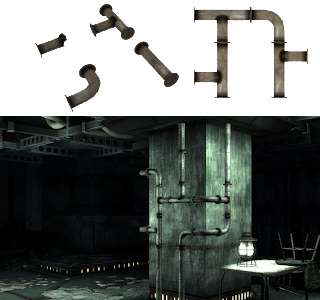Next week is the 7DFPS challenge – design, code, ship a game in 7 Days, on the theme of “first person shooter”. I want to do something unique and interesting. Here’s one of my ideas.
(if you like this idea, please re-tweet this to vote for it – I’ll decide which to do based on which one(s) people like most) Other ideas: “Runners”, “Metamorphosis”)
Title: “Follow”
Premise: what makes an FPS unique/special among games is the visceral, immersive nature. Almost every *other* genre of game gives you 360-degree vision. This was originally to compensate for the way “a computer” fails to use most of your human “peripheral” senses (depth, perpheral vision, positional sound, etc). The most obvious difference with FPS’s: you can’t see what’s behind you.
In most FPS’s, you only have to worry about your own skin. You spin around frequently to check no-one is sneaking up on you. You strafe round corners so that a head-on enemy doesn’t get a chance to blindside you as you slowly rotate around the corner. Stealth games let you “lean” to make up for the danger of corners.
Core gameplay
Follow is different: you are invulnerable, and you’re being followed by creatures you’re trying to rescue / lead to safety. Because they’re always behind you, you cannot see when they’re being attacked – you can gun down all opposition, then turn round to find out everyone’s been eaten behind your back.
But if you walk backwards everywhere, you’re bound to fall off a cliff, or run into an enemy and only notice it when your followers go down in a hail of fire.
Challenges to the player
Moment to moment during the game, the player has to compromise between the following tensions:
- Avoid static obstacles/dangers (look where you run) … vs … prevent followers from wandering off (look behind you, at followers)
- Takedown enemies (charge forwards, run around obstacles) … vs … lead carefully (avoid leading your followers into traps / fields of fire)
- Hands-off (followers wander and get into danger) … vs … Hands-on (use non-lethal weapons to herd and cluster your followers, so you can keep them alive more easily)
- Get to level-end / safety quickly (lose lots of followers) … vs … slow, stealthy “no man left behind” (slower and painstaking but higher success rate)
Upgrades
Three interwoven upgrade paths:
- Player: might/damage/speed
- Relationship with followers: trust/obedience
- Followers: speed/intelligence/resilience
At end of each level, you get cash in a virtual currency based on how many followers you rescued, how quickly – and how much they like you.
(if you got them to the end by bullying … they won’t like you so much as if you gently nudged throughout)
Weapon availability
Potentially: various unique weapons only “unlocked” when you achieve difficult non-shooting things, e.g.:
- Complete a level with 100% survival of followers
- Keep followers at 90% or above happinness for 5 levels in a row
- Complete a level in under 50% of the “par” time
Ideally, those weapons would be complementary to the achievement. e.g. for the “complete a level fast” award, you’d get something that made it easier to complete levels stealthily (you’ve already mastered “moving fast”, so this gives you something valuable).
…also: if you don’t like playing fast, this gives you a high cost/reward incentive to do so: you want to play stealthily, you want the uber-weapon for stealth … so you need to take a break from stealth-play to go earn it.
Summary
I like this idea because:
- …it’s an FPS about protecting people, rather than slaughtering them
- …it emphasizes the vulnerability of “people other than myself”
- …it demonstrates that making yourself into a super-soldier may be ultimately useless and unrewarding
- …it makes the purely-tactical parts of an FPS a lot more strategic, as core gameplay – rather than relying upon “map design” and/or “multiplayer team tactics” to provide all the strategy







